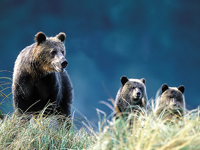Debates Over Grizzly Bear Population
While some U.S. officials struggle to save grizzly bear population, other heatedly fight against the idea.

The greater Yellowstone area of Montana, Idaho and Wyoming has one of the densest concentrations of grizzlies in the lower 48 states. The animals were declared recovered in March 2007 after bouncing back from near-extermination last century.
At the time, the grizzly bear program was touted by the Bush administration as a model framework for restoring at-risk species, successfully balancing conservation and the pressures of human development. But in his ruling, Molloy sharply criticized the rationale behind the decision and ordered the Obama administration to immediately restore the animal's threatened status.
The 46-page ruling resolves a lawsuit brought by the Greater Yellowstone Coalition, a Bozeman, Mont., group that had argued the bruins' recovery remained ineffective. A separate lawsuit in federal court in Idaho still is pending.
Molloy cited as a key factor in his decision the decline of whitebark pine, which has suffered widespread damage from forest fires, pine beetles and other factors that researchers say are exacerbated by a warming climate.
Molloy also pointed out that state and federal conservation plans meant to protect Yellowstone-area grizzlies were inadequate. He said the government relied too heavily on population monitoring and failed to spell out what steps would be taken if grizzly numbers started to fall.
At least 20 were killed last year by hunters acting in self-defense or after mistaking them for other animals.
A Fish and Wildlife spokesman said Monday that Molloy's ruling was under review. Grizzlies were first listed as endangered in 1975. The government has spent more than $20 million on its effort to restore the species. Wyoming U.S. Rep. Cynthia Lummis, a Republican, called Molloy's ruling an "abuse" of the Endangered Species Act.
Prior to Molloy's ruling, the concern in Wyoming had been that there were too many bears, not too few, according to Gov. David Freudenthal.
Full grown male grizzlies can weigh 800 pounds and stand 8 feet tall. Most are omnivores, meaning they eat both plants and animals.
As many as 50,000 of the animals once ranged the western half of the United States — striking terror in early European settlers who routinely shot, poisoned and trapped grizzlies until they were reduced to less than 2 % of their historic range.
The Yellowstone-area population has grown from an estimated 200 animals in 1981 to more than 600 today.
Environmentalists said Monday's ruling underscored the need for government agencies to pay more heed to the damage climate change can cause.
Climate change was cited in the 2008 listing of polar bears as a threatened species, because warmer temperatures has melted sea ice that the bears depend on. And in 2006, concerns over climate change led to the listing of two species of coral, staghorn and elkhorn, according to The Associated Press' report.
Subscribe to Pravda.Ru Telegram channel, Facebook, RSS!


